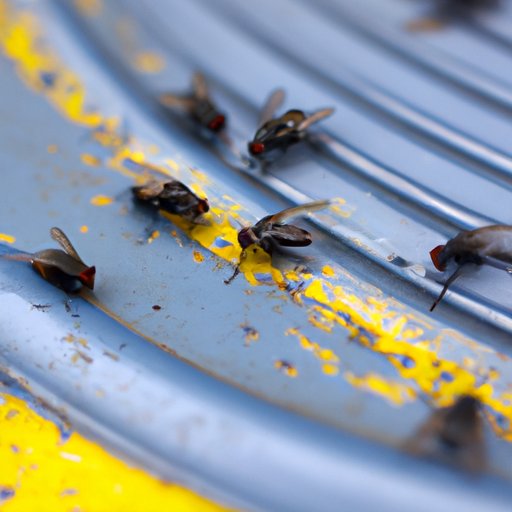
I. Introduction
Have you noticed pesky little flies flying around your drains or toilets? These are sewer flies, and they can be a nuisance to any homeowner. Fortunately, there are simple and effective ways to get rid of them. This article will provide you with seven remedies and solutions to get rid of sewer flies in your home, as well as tips to prevent them from returning.
II. “7 Simple and Effective Ways to Get Rid of Sewer Flies in Your Home”
Here are seven options to help you get rid of sewer flies:
Option 1: Using Apple Cider Vinegar Traps
Mix a cup of apple cider vinegar, a tablespoon of sugar, and a few drops of dish soap in a jar to create a trap. The vinegar attracts the flies, and the dish soap will trap them. Place the jar near the breeding ground and let it sit for a few hours. You should see dead flies in the jar.
Option 2: Cleaning Drains with Baking Soda and Vinegar
Mix a cup of baking soda and a cup of vinegar, then pour it down the drain. Let the mixture sit for a few hours or overnight before rinsing the drain with hot water. This method helps to eliminate any blockage that could be attracting the flies.
Option 3: Bleaching Drains
Flies are usually attracted to moist drains where organic matter accumulates. Pour a cup of bleach down the drain and let it sit overnight. Rinse the drain with hot water in the morning. The bleach will get rid of organic matter and bacteria, hence reducing the breeding ground for the flies.
Option 4: Using Flypaper Strips
Hang up flypaper strips near the source of the infestation to trap adult flies. The strip contains sticky adhesive substances that trap the flies, preventing them from flying away.
Option 5: Using Essential Oils
Sewer flies are repelled by certain oils such as peppermint, lavender, and tea tree oil. Mix ten drops of your preferred essential oil with half a cup of water and spray it near the breeding ground. Repeat this procedure daily until the infestation is gone.
Option 6: Installing Mesh Screens
Prevent sewer flies from entering your home by installing mesh screens over your vents or windows. This helps to keep the flies from invading your home in search of breeding grounds.
Option 7: Hiring a Professional Exterminator
If the infestation is severe or you have tried all the home remedies above without success, call a professional exterminator. They have the proper equipment and expertise to eliminate the infestation and prevent future ones.
III. “The Ultimate Guide to Preventing Sewer Flies in Your Home”
Prevention is key to avoiding future sewer fly infestations. Here are some tips:
Regularly Cleaning Drains and Sinks
Clean your drains and sinks regularly to prevent organic matter from accumulating, which attracts flies.
Fixing Plumbing Leaks
Repair any leaks or damaged pipes to reduce moisture, which is a breeding ground for sewer flies.
Covering Drains When Not in Use
Use sink stoppers or drain covers to prevent flies from entering your home through the drains.
Keeping Your Home Dry and Humidity Low
Use a dehumidifier to keep the humidity below 50 percent in your home, as sewer flies require a humid environment to breed.
Regularly Removing Waste and Garbage
Dispose of waste and garbage in tightly sealed bins to prevent odors that can attract flies.
IV. “5 Essential Products for Eliminating Sewer Flies”
Here are some products that can help you get rid of sewer flies:
Fly Traps
Plastic fly traps can be hung up near the breeding ground, effectively attracting and trapping adult flies seeking to mate and lay eggs.
Insecticide Sprays
Insecticide sprays such as Raid can be used to kill adult flies and their larvae.
Drain Covers
Stops your drains from collecting organic debris that attracts flies.
Mesh Screen Covers
Prevent flies from entering your home through your vents or windows.
Essential Oils
Certain essential oils such as peppermint, lavender, and tea tree oil help repel sewer flies.
V. “Sewer Flies Be Gone! How to Eliminate Infestations for Good”
Here are three additional tips to help you get rid of sewer flies:
Identifying Hidden Breeding Grounds
Identifying all the possible breeding grounds, including cracks in the walls and floors or hard-to-reach areas, helps to eliminate the infestation entirely.
Calling a Professional Exterminator
Consult an exterminator for help with severe infestations. They will assess your home and recommend the best course of action to get rid of the flies.
Treating the Entire House, Not Just One Room
Since sewer flies can travel, it’s essential to treat the entire house, not just the room with the infestation. This ensures that the flies don’t reinvade your home after treatment.
VI. “Why Sewer Flies Are Invading Your Home and How to Stop Them”
Understanding why sewer flies are invading your home can help stop them from returning. Here are some potential causes and solutions:
Causes of Sewer Fly Infestations
Sewer flies are usually attracted to dark, wet, and humid environments that contain organic debris. They usually breed in moist pipes or drains, and may also get into homes through vents or windows.
Reducing Humidity in Your Home
Flies require a humid environment to breed, so it’s crucial to keep the humidity levels in your home below 50 percent, by using dehumidifiers and proper ventilation.
Fixing Faulty Plumbing
Repair faulty plumbing, leaks, and cracks to eliminate any potential breeding grounds.
VII. Conclusion
Sewer flies can be a real nuisance to homeowners. Fortunately, there are simple remedies and solutions to get rid of them. Remember to regularly clean your drains and sinks, fix any leaks, and cover your drains when not in use, among other prevention strategies we have outlined in this article. If the infestation is severe, do not hesitate to call in a professional to help you get rid of the infestation and prevent any future ones.




